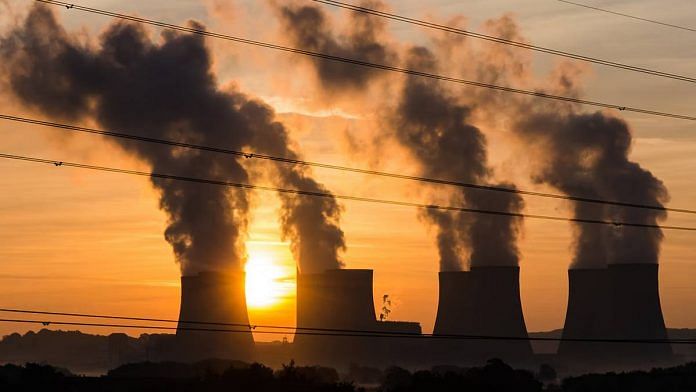New Delhi: India has to do a lot more to meet its net-zero emission target as fossil fuel subsidies are nine times higher than those for clean energy, despite a 72 per cent fall in the former since 2014, says a study by the think tanks International Institute for Sustainable Development (IISD) and the Council on Energy, Environment and Water (CEEW).
The energy sector received over Rs 5,40,000 crore in support from the government in 2021 with Rs 2,17,737 crore in subsidies, according to the report, titled ‘Mapping India’s Energy Policy 2022: Aligning Support and Revenues with a Net-Zero Future’ and released 31 May.
Subsidies to renewable energy dropped 59 per cent to settle at Rs 6,767 crore after a high of Rs 16,312 crore in 2017, the study finds, attributing it to “falling year-on-year installations and benchmark costs, as well as gradual declines in accelerated depreciation benefits as assets age.”
The study reviews India’s energy policies to see how they align with the country’s target of net-zero emissions by 2070, an announcement made by Prime Minister Narendra Modi at the COP26 summit in November last year. Net-zero emissions refer to achieving an overall balance between greenhouse gas emissions produced and removed from the atmosphere.
Support from Public Sector Undertakings (PSUs) and Public Financial Institutions (PFIs) to enact India’s energy transition is weak, the study says.
The government, it adds, should move public support away from fossil fuels, and to clean energy, in a socially responsible way.
“PSUs, PFIs, and the ministries should prepare roadmaps and scenarios on net-zero, identifying short-term actions to contribute to energy transition, including strategies on stranded asset risk, compliance with emerging environmental, social, and governance norms, phasing out finance for fossil fuels, and increasing investment and lending for clean energy to crowd in private investments,” it says.
‘PSUs, PFIs need to step up engagement’
Renewable Energy (RE) makes up 23 per cent of India’s energy capacity. While India has pledged to increase its non-fossil-energy capacity to 500 gigawatts (GW) and meet half of its energy requirements through renewables by 2030, it crossed the 100-GW-mark in August last year.
“A 2030 target of 280 GW and 140 GW, respectively, implies average annual deployment of 25 GW of solar PV and 11 GW of wind per year — a steep change in pace and requiring storage,” the study notes, adding that this may require an investment of Rs 1.5 lakh crore to 2 lakh crore per year.
Apart from subsidies, PSUs and PFIs can do more to enable India’s energy transition. PSUs “account for over 50 per cent of power generation, 90 per cent of electricity distribution, 90 per cent of coal mining, 57 per cent of crude oil refining, and almost 100 per cent of the distribution of petroleum products”, but the seven Maharatna PSUs “invested 11 times more in fossil projects than RE”, says the study.
“Consultations with PSU officials suggest that it is challenging for PSUs to make a bold transition to clean energy business models without a clear mandate from the ministries that manage them. This suggests that ministries should explicitly direct PSUs to support clean energy targets,” it adds.
Similarly, public financial institutions invested three times more in fossil fuels than in clean energy, the study says. “No PFIs have established plans on phasing out finance for fossil fuels despite risks of large-scale asset stranding,” the study adds.
Earlier this year, an analysis of the investments of 34 public and private banks by think tank Climate Change Horizons found that most of them were unprepared for climate-related risks.
‘Shift in policies must’
With fossil fuels accounting for 17.5 per cent (Rs 6,99,565 crore) of India’s energy-related revenue, the margin is way higher than countries like China (4.2 per cent) and Brazil and South Africa (6.8 per cent).
The study finds that earnings from fossil fuels are likely to go up at least in the next few years, but the range of earnings varies.
“We estimate fossil energy revenue could grow by an additional Rs 30,000 to Rs 3,40,000 crore by 2030. The large range reflects the uncertainty in the pace of policy shifts to clean energy and how much progress is made toward India’s net-zero target. Beyond 2030, as fossil fuel use begins to peak and decline, revenues will ultimately fall significantly,” it says.
Although subsidies for electric vehicles have tripled to Rs 849 crore from 2017, they constitute just 0.4 per cent of the mix.
Among other measures suggested for course correction, the study recommends the establishment of “a body to coordinate actions across support, taxation, and pricing for energy, with relevant ministries, departments, and expert agencies to bring policy coherence”.
At the same time, it has called for setting aside higher revenue on fossil fuels for special cases. This, the study suggests, can be used to improve social protection and public services to reduce living costs, as well as to improve security and reduce volatility in the medium term.
(Edited by Tony Rai)
Also read: India among 15 countries whose fossil fuel production exceeds Paris Agreement goals: UN report






